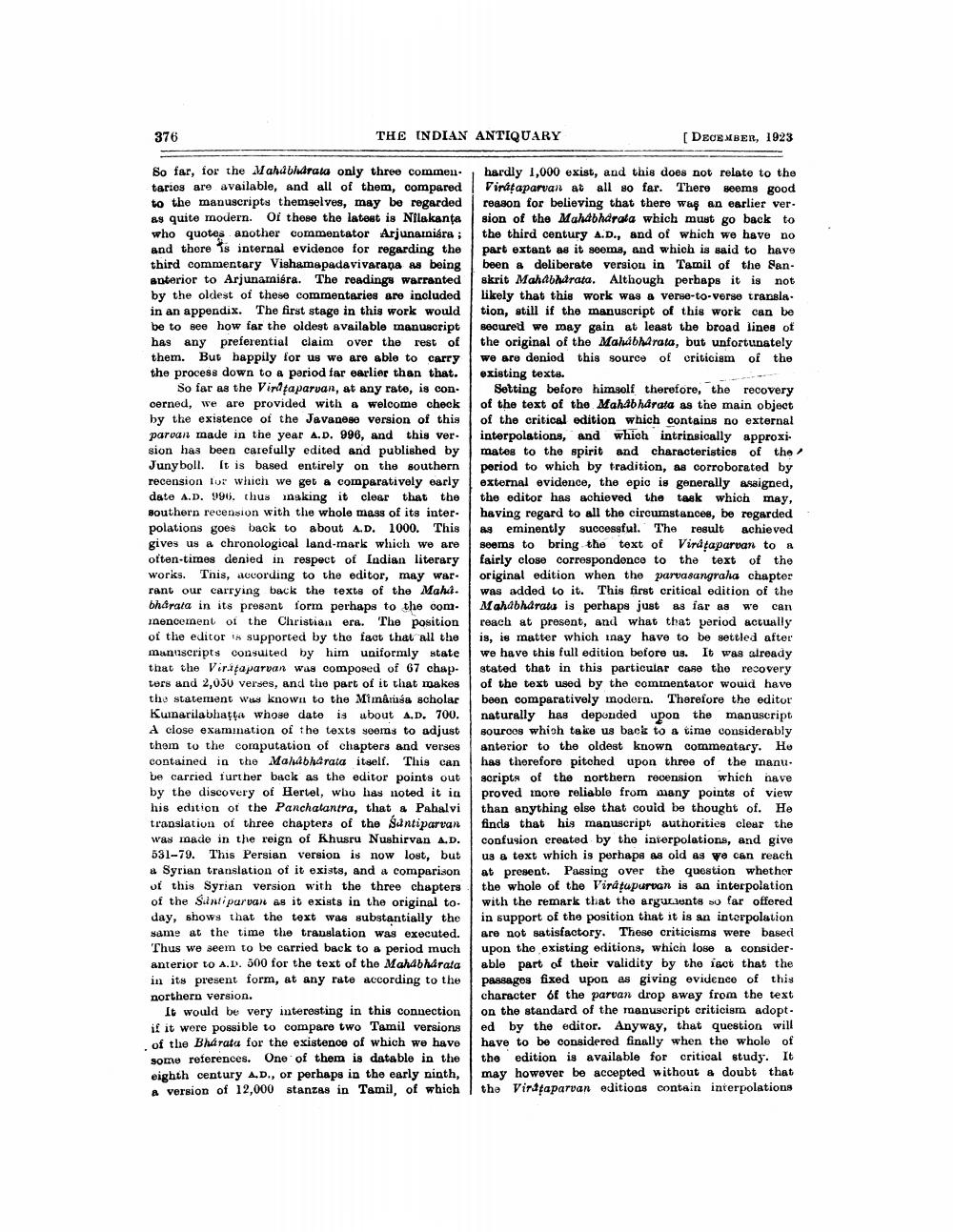________________
376
THE INDIAN ANTIQUARY
So far, for the Mahabharata only three commen. taries are available, and all of them, compared to the manuscripts themselves, may be regarded as quite modern. Of these the latest is Nilakanţa who quotes another commentator Arjunamiśra; and there is internal evidence for regarding the third commentary Vishamapadavivarana as being anterior to Arjunamiśra. The readings warranted by the oldest of these commentaries are included in an appendix. The first stage in this work would be to see how far the oldest available manuscript has any preferential claim over the rest of them. But happily for us we are able to carry the process down to a period far earlier than that. So far as the Virataparvan, at any rate, is con cerned, we are provided with a welcome check by the existence of the Javanese version of this parvan made in the year A.D. 996, and this version has been carefully edited and published by Junyboll. It is based entirely on the southern recension for which we get a comparatively early date A.D. 996. thus making it clear that the southern recension with the whole mass of its interpolations goes back to about A.D. 1000. This gives us a chronological land-mark which we are often-times denied in respect of Indian literary works. This, according to the editor, may war. rant our carrying back the texts of the Maha. bharata in its present form perhaps to the commencement of the Christian era. The position of the editor is supported by the fact that all the manuscripts consulted by him uniformly state that the Virataparvan was composed of 67 chapters and 2,050 verses, and the part of it that makes the statement was known to the Mimâmsa scholar Kumarilabhatta whose date is about A.D. 700. A close exammation of the texts seems to adjust them to the computation of chapters and verses contained in the Mahabharata itself. This can be carried further back as the editor points out by the discovery of Hertel, who has noted it in his edition of the Panchatantra, that a Pahalvi translation of three chapters of the Santiparvan was made in the reign of Khusru Nushirvan A.D. 531-79. This Persian version is now lost, but a Syrian translation of it exists, and a comparison of this Syrian version with the three chapters of the Santiparvan as it exists in the original to day, shows that the text was substantially the same at the time the translation was executed. Thus we seem to be carried back to a period much anterior to A.D. 500 for the text of the Mahabharata in its present form, at any rate according to the northern version.
It would be very interesting in this connection if it were possible to compare two Tamil versions of the Bharata for the existence of which we have some references. One of them is datable in the eighth century A.D., or perhaps in the early ninth, a version of 12,000 stanzas in Tamil, of which
[DECEMBER, 1923
hardly 1,000 exist, and this does not relate to the Viráṭaparvan at all so far. There seems good reason for believing that there was an earlier version of the Mahabharata which must go back to the third century A.D., and of which we have no part extant as it seems, and which is said to have been a deliberate version in Tamil of the Sanskrit Mahabharata. Although perhaps it is not likely that this work was a verse-to-verse transla. tion, still if the manuscript of this work can be secured we may gain at least the broad lines of the original of the Mahabharata, but unfortunately we are denied this source of criticism of the existing texts.
Setting before himself therefore, the recovery of the text of the Mahabharata as the main object of the critical edition which contains no external interpolations, and which intrinsically approxi mates to the spirit and characteristics of the period to which by tradition, as corroborated by external evidence, the epic is generally assigned, the editor has achieved the task which may, having regard to all the circumstances, be regarded as eminently successful. The result achieved seems to bring the text of Viraṭaparvan to a fairly close correspondence to the text of the original edition when the parvasangraha chapter was added to it. This first critical edition of the Mahabharata is perhaps just as far as we can reach at present, and what that period actually is, is matter which may have to be settled after we have this full edition before us. It was already stated that in this particular case the recovery of the text used by the commentator would have been comparatively modern. Therefore the editor naturally has depended upon the manuscript sources which take us back to a time considerably anterior to the oldest known commentary. He has therefore pitched upon three of the manu. scripts of the northern recension which have proved more reliable from many points of view than anything else that could be thought of. He finds that his manuscript authorities clear the confusion created by the interpolations, and give us a text which is perhaps as old as we can reach at present. Passing over the question whether the whole of the Viráṭapurvan is an interpolation with the remark that the arguments so far offered in support of the position that it is an interpolation are not satisfactory. These criticisms were based upon the existing editions, which lose a consider. able part of their validity by the fact that the passages fixed upon as giving evidence of this character of the parvan drop away from the text on the standard of the manuscript criticism adopted by the editor. Anyway, that question will have to be considered finally when the whole of the edition is available for critical study. It may however be accepted without a doubt that the Virataparvan editions contain interpolations




